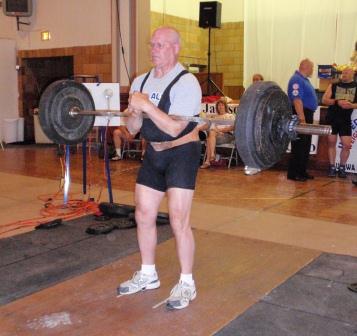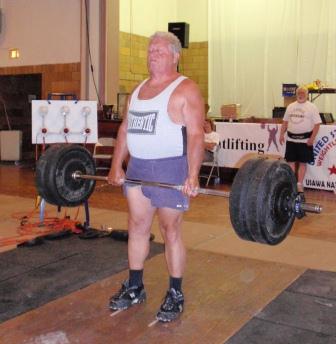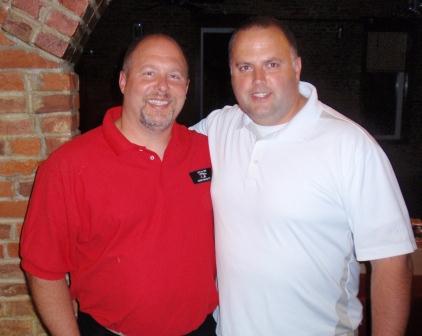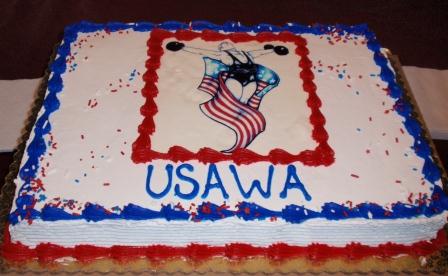by Al Myers, USAWA Secretary
Minutes from the 2011 Annual National Meeting
The 2011 USAWA Annual National Meeting was called to order by USAWA President Denny Habecker. The meeting started promptly at 6:30 PM on June 24th in the Jackson Weightlifting Club’s Training Hall. Roll call was taken and these 12 USAWA members were in attendance: Denny Habecker, Al Myers, Thom Van Vleck, John O’Brien, Rudy Bletscher, Randy Smith, Helen Kahn, Judy Habecker, Dennis Mitchell, Larry Traub, Chad Ullom, and Joe Garcia. The first agenda item was the reading of the previous meeting’s minutes by USAWA Secretary Al Myers. Although they were quite long and boring, Randy Smith still moved that they be accepted. Chad Ullom provided the second and they were passed unanimously. The next item was the financial report by USAWA Treasurer Al Myers. A net loss for the year of $1242.60 was reported. A budget for 2011 was presented that had been prior approved by the Executive Board. Chad Ullom moved to accept the report, with a second by Thom Van Vleck, and it was passed unanimously. The next report given was by the Officials Director Joe Garcia. Joe detailed the number of current officials, along with a suggestion that it was time to update the Officials Test. The next report given was by the Website Director Al Myers. Several of the website statistics, along with some general comments regarding soliciting sponsorship for the USAWA by using the website as the means of giving our sponsors advertising exposure was reported. The next agenda item was the report from the Records Director Joe Garcia. Joe reported that the USAWA Record List is approaching 10,000 records. He also gave some interesting statistics regarding the records. The report from the Awards Director Al Myers was next. The report explained the purpose of the award programs and what awards were given this past year on behalf of the USAWA. Chad Ullom, the Drug Enforcement Director, gave his report next. He explained our current drug testing program, and how it has been improved by testing more competitions and more competitors.
The next agenda item was the discussion and vote on 6 new proposed USAWA lifts. These six lifts were: the Appollons Lift, the Cyr Press, the Saxon Snatch, the Dinnie Lift, the Goerner Stroll, and the Jackson Press. After a little discussion, Larry Traub moved these lifts be accepted, which was seconded by Judy Habecker. An amendment to the motion was made by Al Myers to accept as USAWA records in these lifts any records that have been done during this past year under the proposed rules. The amendment was seconded by Judy Habecker and the motion passed unanimously. At this point a vote was called on accepting the proposed lifts and it passed unanimously. At this point as required by our USAWA rules, a call from the floor was made to ask if anyone had an official USAWA lift they wanted proposed to IAWA for acceptance. Only one lift was proposed, and that lift was the Bent Over Row as proposed by Al Myers on behalf of John McKean. Chad Ullom provided the second and it was passed unanimously. The next item was several proposed USAWA Rulebook changes that was presented by Al Myers on behalf of the Executive Board. Most of the proposed Rulebook changes were to bring the USAWA rules into compliance with the IAWA rules. After reading all of the proposed changes, only one item caused the membership to be in disagreement, and that was the rule involving the Bench Press – Feet in Air. The proposed change was to allow a bench to rest the lower legs on during the lift, as allowed by the IAWA. Judy Habecker moved to strike this proposed change from the list, with Chad Ullom providing the second. A vote was taken and the motion was upheld with a vote of 8 in favor, 1 opposed, and 3 abstaining. After some more discussion, Chad Ullom moved to accept the remaining Rulebook changes. Judy Habecker provided a second. Al Myers moved to amend the motion by adding that the new proposed rules take effect August 1st, to allow time for the updated Rule Book to be put on the website. Judy Habecker provided a second, and the amendment passed unanimously. A vote on the amended motion was then called for, and it passed unanimously. The next agenda item was the development of an online store on the USAWA website. Website Director Al Myers explained how this could benefit the membership by allowing purchase of USAWA promotional items, rulebooks, and other items off the website. Also explained was the upfront expense of around $500-$1000 that would be required to make this happen to allow for the saleable items to be bought before they would be sold. The membership seemed to be in agreement on this, and Chad Ullom moved that up to $1000 be used to develop an online store under the direction of Al Myers. Judy Habecker provided the second and the motion passed unanimously. The next agenda item was any other new business brought forth by the membership. The discussion of lifetime membership was the only item brought up. Several members were in disagreement on whether this would be beneficial for the USAWA. After much discussion, Chad Ullom moved that this item be looked into further by forming a committee that would report back to the membership at the next meeting. Rudy Bletscher provided a second and the motion passed unanimously. The ad hoc committee that was formed consisted of Al Myers, Judy Habecker, and Randy Smith.
At this point, USAWA President asked if there were any bids for the 2012 National Championships. There were none. Judy Habecker moved that the Executive Board be responsible for finding a venue for the next year. Chad Ullom gave the second, and it passed unanimously. The last item was the election of officers. Judy Habecker moved that the current officers and Executive Board members be retained for another term. These officers include: President – Denny Habecker, Vice President – Chad Ullom, Secretary/Treasurer – Al Myers, at large Executive Board Members – Dennis Mitchell and Scott Schmidt. Larry Traub provided the second, and the motion passed unanimously. At this point Thom Van Vleck announced that the steaks were done and it was time to eat. The meeting was in session for 1.5 hours. Judy Habecker moved to adjourn, Chad Ullom provided a second, the motion passed unanimously, and everyone quickly exited for the supper table.



